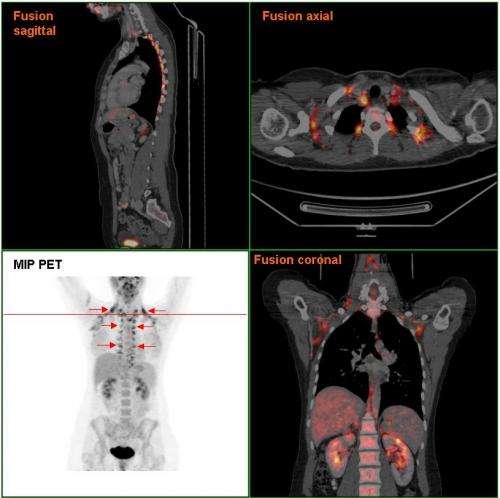Molecular switch generates calorie-burning brown fat

A research team led by UC San Francisco scientists has identified a molecular switch capable of converting unhealthy white fat into healthy, energy-burning brown fat in mice. Drugs that flip this switch rapidly reduced obesity and diabetes risk factors in mice fed a high fat diet.
The results suggest that drugs capable of targeting similar molecular pathways in human fat cells could one day become major tools for fighting the growing worldwide epidemics of obesity and type 2 diabetes, according to senior investigator Shingo Kajimura, PhD, an assistant professor of cell and tissue biology in UCSF's School of Dentistry. He holds a joint appointment in UCSF's Diabetes Center and Eli and Edythe Broad Center of Regeneration Medicine and Stem Cell Research.
The research appears Oct. 29, 2015 in the journal Cell Metabolism.
All mammals, including humans, have two types of fat with completely opposite functions: white, which stores energy and is linked with diabetes and obesity; and brown, which produces heat by burning energy and is associated with leanness. Human babies are born with brown fat as a natural defense against cold. Hibernating animals such as bears build up large stores of brown fat for the same reason.
Many obesity researchers hope to harness the energy-burning capacity of brown fat to help patients lose weight: just two ounces of the stuff can burn up to 200 calories a day when the temperature drops. But drugs that simply activate existing brown fat have proven ineffective in early trials because most people who are obese lack a significant amount of active brown fat, Kajimura explained. Early drugs also had dangerous cardiovascular side effects, which are of particular concern in obese patients.
Researchers discover a protein that tells white fat to hoard calories
In a major breakthrough earlier this year, Kajimura's group showed for the first time that brown fat in adult humans consists primarily of so-called "beige fat," which can transform from white to brown in cold conditions. The discovery immediately suggested a new approach for treating obesity: enhancing people's baseline stores of energy-burning brown fat, known as the "browning" of white fat.
In the new paper, Kajimura's team collaborated with the laboratory of Yasushi Ishihama, PhD, of the University of Kyoto, Japan, to search for differences in how white and brown fat cells respond to the cold using a technique called phosphoproteomics. They discovered a protein called Casein Kinase 2 (CK2), which appears to be responsible for preventing white fat from burning energy for heat in cold conditions. When researchers inhibited the activity of this molecule genetically or pharmacologically, white fat cells lit up their cellular furnaces, becoming calorie burners like their brown and beige brethren.
"It was quite surprising," Kajimura said. "This one protein turned out to be the switch that regulates whether fat cells burn energy or not."
CK2 activity is also heightened in obese mice, the team discovered, suggesting a link between obesity and the loss of brown fat.
"When we feed mice high fat foods, which is like going to McDonalds every day, they become obese and lose most of their brown fat," said study lead author Kosaku Shinoda, a postdoc in Kajimura's lab. "We think this molecule could be an important link."
CK2-blocking drugs boost metabolism, prevent weight gain
The researchers tested two anti-CK2 drugs for their ability to stimulate the production of new brown fat in mice: a new small-molecule CK2-blocker called silmitasertib (CX-4945), which is already in clinical trials as a cancer therapeutic; and a more precise next-generation antisense oligonucleotide (ASO) drug developed in collaboration with Isis Pharmaceuticals, which eliminates CK2 by blocking the RNA instructions cells use to produce it.
Both drugs succeeded in turning significant amounts of white fat brown and significantly increasing the amount of energy mice burned when researchers turned down the temperature in their living quarters. The drugs also significantly reduced the negative effects of a high-fat diet in mice, including reducing weight gain and, to the researchers' surprise, significantly lowering blood glucose levels and improving responsiveness to insulin.
"This was very exciting to us," Kajimura said. "In the past people have focused on all the beneficial effects of brown fat for treating obesity, but here we've found that it could help reduce the risk of type 2 diabetes, as well."
The team also showed that CK2 inhibition and cool conditions complement each other to dramatically reduce obesity in mice. Normally, mice fed a high fat diet for 45 days quickly balloon to nearly 160 percent of their starting weight. Treating mice with CK2-ASO or housing them at 17 degrees C (62.6 degrees F) each prevented more than 25 percent of this weight gain. But in combination the two treatments reduced weight gain by fully 40 percent.
The researchers are now examining whether CK2-inhibitors can effectively reduce obesity as well as prevent it, and whether they can be used alongside next-generation drugs that mimic the effects of cold to trigger brown fat to burn energy in humans.
Kajimura is hopeful but cautious about the prospects for using these drugs to treat human obesity in the near future. "It's exciting, but we still have a lot to learn about the mechanisms, specificity of action and safety," he said. "For now, it's just time to set the science in progress. Once we know more, everything else will fall into place."


















